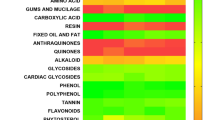Abstract
Previous studies have demonstrated that 3′-hydroxy-5,6,7,4′-tetramethoxyflavone (TMF) content in Orthosiphon stamineus fractions correlate with its vasorelaxation activity. Even with the availability of previous studies, there is still very little information on the vasorelaxation effect of TMF, and few scientific studies have been carried out. Therefore, the present study was designed to investigate the vasorelaxation activity and mechanism of action of the TMF. The vasorelaxation activity and the underlying mechanisms of TMF were evaluated on thoracic aortic rings isolated from Sprague Dawley rats. TMF caused the relaxation of aortic rings with endothelium pre-contracted with phenylephrine. However, the vasorelaxant effect of TMF was significantly decreased in PE-primed endothelium-denuded and potassium chloride-primed endothelium-intact aortic rings. In the presence of Nω-nitro-l-arginine methyl ester, methylene blue, 1H-[1,2,4]oxadiazolo[4,3-a]quinoxalin-1-one, indomethacin, tetraethylammonium, 4-aminopyridine, barium chloride, atropine and propranolol, the relaxation stimulated by TMF was significantly reduced. TMF was also found to reduce Ca2+ release from sarcoplasmic reticulum (via IP3R) and block calcium channels (VOCC). The present study demonstrates the vasorelaxant effect of TMF involves NO/sGC/cGMP and prostacyclin pathways, calcium and potassium channels and muscarinic and beta-adrenergic receptors.





Similar content being viewed by others
References
Gruetter CA, Barry BK, McNamara DB, Gruetter DY, Kadowitz PJ, Ignarro L (1979) Relaxation of bovine coronary artery and activation of coronary arterial guanylate cyclase by nitric oxide, nitroprusside and a carcinogenic nitrosoamine. J Cyclic Nucleotide Res 5(3):211–224
Ignarro LJ, Lippton H, Edwards JC, Baricos WH, Hyman AL, Kadowitz PJ, Gruetter CA (1981) Mechanism of vascular smooth muscle relaxation by organic nitrates, nitrites, nitroprusside and nitric oxide: evidence for the involvement of S-nitrosothiols as active intermediates. J Pharmacol Exp Ther 218(3):739–749
Ishii M, Kurachi Y (2006) Muscarinic acetylcholine receptors. Curr Pharm Des 12(28):3573–3581
Iwamuro Y, Miwa S, Minowa T, Enoki T, Zhang X, Ishikawa M, Hashimoto N, Masaki T (1998) Activation of two types of Ca2+-permeable nonselective cation channel by endothelin-1 in A7r5 cells. Br J Pharmacol 124(7):1541–1549
Jin SN, Wen JF, Li X, Kang DG, Lee HS, Cho KW (2011) The mechanism of vasorelaxation induced by ethanol extract of Sophora flavescens in rat aorta. J Ethnopharmacol 137(1):547–552
Koon C, Fong S, Wat E, Wang Y, Cheung DW, Lau CB, Leung P, Sun H, Zhao Q, Fung K (2014) Mechanism of the dilator action of the Erigerontis Herba on rat aorta. J Ethnopharmacol 155(3):1561–1567
Loh YC, Tan CS, Ch’ng YS, Ahmad M, Mohd ZA, Yam MF (2016) Overview of antagonists used for determining the mechanisms of action employed by potential vasodilators with their suggested signaling pathways. Molecules 21(4):495
Loh YC, Tan CS, Ch'ng YS, Ahmad M, Ng CH, Yam MF (2017) Overview of signaling mechanism pathways employed by BPAid in vasodilatory activity. J Med Food 20(12):1201–1213
McFadzean I, Gibson A (2002) The developing relationship between receptor-operated and store-operated calcium channels in smooth muscle. Br J Pharmacol 135(1):1–13
Nelson MT, Standen MB, Brayden JE, Worley JF (1988) Noradrenaline contracts arteries by activating voltage dependent calcium channels. Nature 336(6197):382–385
Senejoux F, Demougeot C, Cuciureanu M, Miron A, Cuciureanu R, Berthelot A, Girard-Thernier C (2013) Vasorelaxant effects and mechanisms of action of Heracleums phondylium L. (Apiaceae) in rat thoracic aorta. J Ethnopharmacol 147(2):536–539
Tan CS, Ch’ng YS, Loh YC, Mohd ZA, Ahmad M, Yam MF (2017) Vasorelaxation effect of Glycyrrhizae uralensis through the endothelium-dependent pathway. J Ethnopharmacol 199:149–160
Trimarco V, Cimmino CS, Santoro M, Pagnano G, Manzi MV, Piglia A, Giudice CA, Giudice Luca ND, Izzo R (2012) Nutraceuticals for blood pressure control in patients with high-normal or grade 1 hypertension. High Blood Press Cardiovasc Prev 19(3):117–122
Yam MF, Tan CS, Ahmad M, Shibao R (2016a) Mechanism of vasorelaxation induced by eupatorin in the rats aortic ring. Eur J Pharmacol 789:27–36
Yam MF, Tan CS, Ahmad M, Shibao R (2016b) Vasorelaxant action of the chloroform fraction of Orthosiphon stamineus via NO/cGMP pathway, potassium and calcium channels. Am J Chin Med 44(7):1413–1439
Yam MF, Tan CS, Shibao R (2018) Vasorelaxant effect of sinensetin via NO/sGC/cGMP pathway, potassium, and calcium channels. Hypertens Res, in press
Xu YC, Leung SW, Yeung DK, Hu LH, Chen GH, Che CM, Man RY (2007) Structure-activity relationships of flavonoids for vascular relaxation in porcine coronary artery. Phytochemistry 68(8):1179–1188
Yildiz O, Gul H, Seyrek M (2013) Pharmacology of arterial grafts for coronary artery bypass surgery. In: Aronow WS (ed) Artery bypass. Intech Open Access Publisher, Rijeka. https://doi.org/10.5772/54723
Author information
Authors and Affiliations
Corresponding author
Ethics declarations
All the procedure described herein were approved by animal ethics committee USM (no. of animal ethics approval: USM/Animal Ethics Approval/2016/(103)(772).
Conflict of interest
The authors declare that they have no conflict of interest.
Additional information
Highlight of the manuscript:
• TMF might be one of the antihypertensive compounds from Orthosiphon stamineus (Jawa tea).
• TMF exhibits vasorelaxant effect on aortic ring assay.
• The vasorelaxant effect of TMF involves multi-pathways.
• TMF induces vasorelaxation via Kv, Kir and KCa VOCC channels and IP3 receptor.
• The vasorelaxant effect of TMF involves NO/sGC/cGMP pathway
Rights and permissions
About this article
Cite this article
Tan, C.S., Yam, M.F. Mechanism of vasorelaxation induced by 3′-hydroxy-5,6,7,4′-tetramethoxyflavone in the rats aortic ring assay. Naunyn-Schmiedeberg's Arch Pharmacol 391, 561–569 (2018). https://doi.org/10.1007/s00210-018-1481-9
Received:
Accepted:
Published:
Issue Date:
DOI: https://doi.org/10.1007/s00210-018-1481-9




